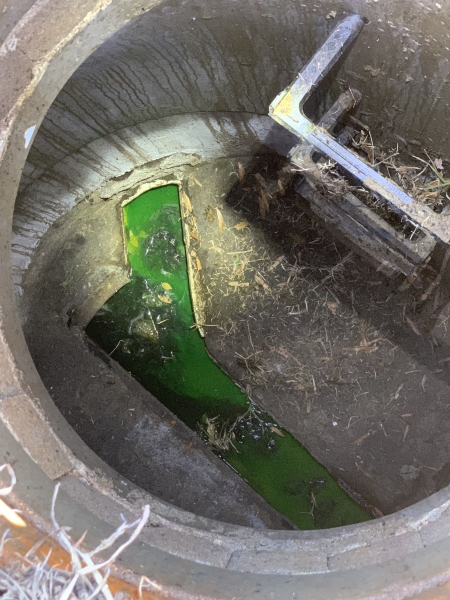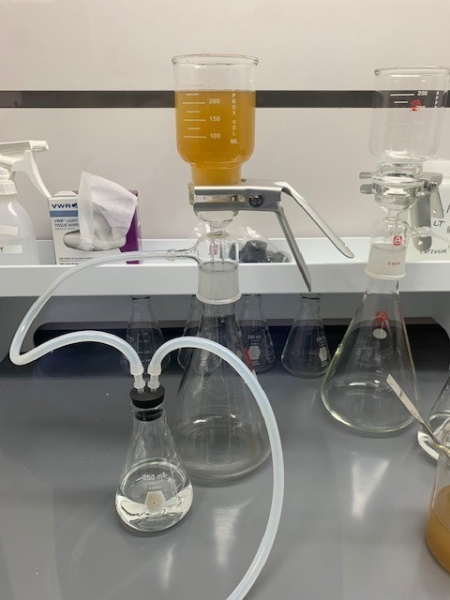Comparing the Swab to the Sewer
Duke pilot testing effectiveness of campus wastewater sampling to detect SARS-CoV-2, and comparing it to nasal swabs

DURHAM, N.C.—Using established methods for screening human sewage for the presence of SARS-CoV-2, the virus that causes COVID-19, Duke University is piloting a study to compare what can be learned from sewage with what can be learned from a rigorous nasal swab testing program.
The university has been testing wastewater from three residence halls for the virus and comparing that data to what is being learned from swab testing across campus.
“Duke had the resources to conduct individual sampling, which is the gold standard,” said Sonia Grego, an electrical and computer engineer with the Duke Center for Water, Sanitation, Hygiene and Infectious Disease, or WaSH-AID, which is conducting the sewage testing.
But the testing system Duke has established, including dozens of temporary lab workers to handle thousands of samples daily, has been expensive. “It’s certainly more cost-effective to pool-test through wastewater,” said Grego.
Because of the way humans can shed the virus in their stool, wastewater sampling has the potential to identify an outbreak of infections even before people are exhibiting symptoms. But it would never replace individual testing, Grego is quick to add.

Wastewater sampling for public health isn’t new; the United Nations monitors wastewater in the last few geographical pockets where the polio virus lingers, and the technique is also used in areas of the world prone to outbreaks of typhoid and cholera. In the U.S., the Centers for Disease Control and Prevention recently launched a national wastewater surveillance system to better understand how COVID-19 spreads within communities. And universities across the U.S. have been using wastewater sampling since the current pandemic arose, in the absence of individual nasal swab surveillance like Duke’s.
In cooperation with Duke Facilities Management, autosamplers collect small amounts of wastewater coming from three residence halls throughout the day and mix it all together, ensuring the daily sample better represents everyone living in the building.
From the large sample, the Center for WaSH-AID’s lab cooks it down to a smaller concentrate, then delivers it to the lab of civil and environmental engineer Claudia Gunsch. Gunsch, an expert in identifying microbes and microbial assemblies, extracts RNA from the concentrate. The RNA is then screened for the unique genetic signatures of SARS-CoV-2 and quantified if present.

Those results are then sent to biology professor Steven Haase, who has led the Duke data modeling team since the swab-based surveillance program began last summer.
Every day, Haase’s team checks the testing data for positive signals, and adapts the distribution of tests to surround the positive cases, checking for further transmission. This semester, data from the wastewater sampling will be used to identify potential hot spots, in addition to the pooled nasal swab tests.
“Here’s why it’s so interesting that this pilot program is happening at Duke,” said Haase. “We have been able to get really good data on where our positives are showing up.”
Haase said this trove of new data will make it possible to benchmark the wastewater sampling method against the nasal swab method. Until now, no one has had the necessary depth of data to compare the two.
“We have a shot at learning something really important here,” said Haase.
Information-sharing among universities has peaked under these unprecedented circumstances, even amongst classic rivals; several researchers at the Gillings School of Global Public Health and Department of Marine Sciences at the University of North Carolina at Chapel Hill—most notably Rachel Noble, Denene Blackwood and Tom Clerkin—have experience in SARS wastewater surveillance and provided the Duke team with valuable tips and protocols for the process.
Duke, in turn, recently published the particulars of its nasal swab pooling procedures for other administrations to emulate if they choose.
Duke’s Office of Housing and Residence Life, in a January 21 email notifying students of the pilot program, noted that the sampling stations may be moved to serve different buildings over the course of the semester in response to the wastewater surveillance team’s findings.
“Determining the sensitivity of wastewater testing is the next big-ticket piece of knowledge that we can share,” noted Grego. “Early identification and isolation will continue to be of critical importance in keeping our bubbles safe until the threat fully recedes.”
